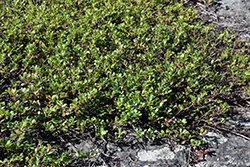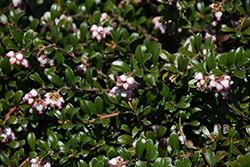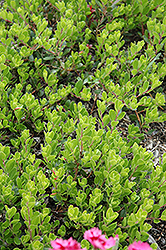Height: 8 inches
Spread: 3 feet
Sunlight:
![]()
![]()
Hardiness Zone: 1b
Other Names: Kinnikinik
Description:
A truly hardy groundcover with special growing requirements; acidic, light sandy soil; has interesting fall color, and is extremely low growing
Ornamental Features
Bearberry features dainty nodding shell pink bell-shaped flowers at the ends of the branches in mid spring. It has forest green evergreen foliage. The tiny glossy round leaves turn burgundy in the fall, which persists throughout the winter. It produces red berries from late summer to late fall.
Landscape Attributes
Bearberry is a multi-stemmed evergreen shrub with a ground-hugging habit of growth. Its relatively fine texture sets it apart from other landscape plants with less refined foliage.
This is a relatively low maintenance shrub, and should not require much pruning, except when necessary, such as to remove dieback. It has no significant negative characteristics.
Bearberry is recommended for the following landscape applications;
- Groundcover
Planting & Growing
Bearberry will grow to be about 8 inches tall at maturity, with a spread of 3 feet. It tends to fill out right to the ground and therefore doesn't necessarily require facer plants in front. It grows at a slow rate, and under ideal conditions can be expected to live for approximately 20 years.
This shrub does best in full sun to partial shade. It is very adaptable to both dry and moist growing conditions, but will not tolerate any standing water. It is considered to be drought-tolerant, and thus makes an ideal choice for a low-water garden or xeriscape application. It is very fussy about its soil conditions and must have sandy, acidic soils to ensure success, and is subject to chlorosis (yellowing) of the foliage in alkaline soils, and is able to handle environmental salt. It is somewhat tolerant of urban pollution. This species is native to parts of North America.
Disclaimer - This resource is provided for informational purposes only and does NOT reflect current availability. Inventory varies seasonally, so we cannot guarantee that every plant will be in stock at all times - please contact your favourite GardenWorks location directly for current availability. It does not include our entire inventory of plants, so be sure to visit GardenWorks to see varieties that may not be represented on this list.



